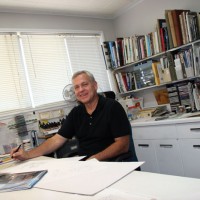Entertainment
Artist in Residence: Ken Clubb
- Details
- Published on Tuesday, 01 November 2011 16:35
- Written by Paul Gordon
Put a pencil or brush in Ken Clubb's hand and magic happens.
It is art in its purest form.
"I'm not one of those people who lives or dies by his career. I have too many other important things in my life for that to be the case. But I will say, there is nothing else I want to do or can ever imagine myself doing," said Clubb.
"In that regard, I have been lucky in that I have been able to make my passion my career," he said. "There are a lot of really talented people out there who have not been able to do that."
Clubb, 60, a Peorian since he was a child, is an illustrator and a commercial artist who does freelance work with pencils and water colors. He also teaches part-time in the graphic design department at Illinois Central College, including a class in water color painting.
His work can be seen in several places around Peoria, including the portraits of the Alwan family that hang at Alwan & Sons Meat Co., the banners that hang from light poles along the riverfront and billboards for Goodwill Industries. The mural painted on the wall of the cafeteria in Caterpillar Building KK in East Peoria is his, commissioned by the company.
As long as he can still get freelance commissioned work, that's what he plans to do. It wasn't always that way, but like many artists industry changes cause life changes.
"I've been doing art almost as long as I can remember, since I was in grade school. So it seemed natural to me to teach it," he said.
He went to Western Illinois University and earned his bachelor of arts degree in art education, taking advantage of a state program in place at the time where some could go to college tuition-free to become teachers. However, so many took advantage of the program there became a glut of teachers and Clubb was unable to find a teaching job.
After two years working at Commercial National Bank, setting up charge accounts, Clubb was hired by Thomas S. Klise Co. in Peoria, a firm that made educational and religious film strips for schools. He did the art work for the film strips.
He found himself out of work in 1989 when the company ceased production because of industry changes. Schools didn't use film strips any more.
So Clubb and his best friend, David Seay, who works at Multi-Ad, opened a freelance studio together and Clubb has been doing that full-time ever since.
While he has tried to adapt to life changes when needed, such as taking on part-time teaching work to supplement his income, there is one thing Clubb hasn't done. Not yet, anyway.
"All my work is still by hand. I'm just old school, I guess. I probably should have integrated computers into work before now, but I haven't," he said, adding he is learning now how to do that while teaching at ICC. That doesn't mean, however, he will use it when he gets commissioned to do artwork.
His first client as a freelance illustrator was Shooting Times magazine, formerly published by the Journal Star. But that magazine and its sister publications were sold and production was either shut down or moved.
It also was indicative of the industry changes Clubb battles now as he hopes for more freelance work. Namely, many publications now get their art from the Internet or use computer-generated art rather than illustrations done by hand.
Clubb said he doesn't necessarily feel he was born decades too late for his craft. But he said there was "a golden age of illustration" early in the last century. "Illustrators were practically revered because of what they could do. But then photography kept getting bigger and bigger, then the computer age took over," he said. "It used to be a picture didn't lie. Now, because of computers, you're not always sure what picture you can believe."
He hopes to be able to retire some day and if he does he would like to get into three-dimensional sculpting. "I like the idea of doing something and let people find the treasurers inside it," he said.
He also would consider doing what he terms "gallery art," with water color being his primary medium and drawing a secondary form.
His need for income — he and his wife Froncie raised three sons and now have four grandchildren — is why Clubb remained a commercial artist rather than a gallery artist. "A commercial artist is someone who has already sold his work, even though he has to do what the person who commissioned him wants. A gallery artist can do whatever type of art or subject he wants, but he then has to sell it. I would like to be able to do that someday, probably in retirement," he said.
"I can't retire yet but it helps that I do enjoy what I'm doing."
Ken Clubb can be reached at kenclubbillustrator@gmail.com


















































